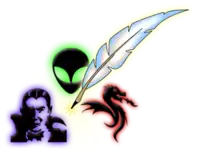Masquerade (trope)
In speculative fiction, a masquerade is a system by which people or creatures living in a wainscot society hide themselves from the outside world.[1] The term was first coined by Robert A. Heinlein's Methuselah's Children in 1958.
 |
| Speculative fiction |
|---|
|
|
In a fantasy context, it means that magic is hidden, whether in secret locations, such as Diagon Alley in Harry Potter, or by magical forces, such as the Mist in Percy Jackson, or a glamour placed on individuals.[1]
That is typically done to avoid some type of mass panic that would result in the destruction of the magical world by far more numerous normal people fearing the unknown.[1] Masquerade societies may seek to hide this information from outsiders, or they may be disbelieved due to ignorance, conspiracies, or consensus reality. In horror-tinged works of fantasy, such as H. P. Lovecraft's Cthulhu Mythos, the Buffyverse, or White Wolf Games' World of Darkness setting, the majority's ignorance of the true horrors of their world may seem like a blessing.
The trope is used not only in fantasy but also in science fiction and superhero stories.[1][2] A common device to keep hidden events from the masses in science fiction is the existence of aliens, such as in the Men in Black series. The secret identities of superheroes are also a type of masquerade, and the only superheroes that show their true identity are ones who can keep their family safe or have nothing to protect.[1]
The masquerade trope benefits writers by adding additional tension to the story and helps it seem more like something plausible.[1] It also saves the author from having to "rewrite history" to explain the existence of magic.[1]
Examples
- Masquerade society from Vampire: The Masquerade
- Harry Potter series by J.K. Rowling
- The Borrowers by Mary Norton
- Neverwhere by Neil Gaiman (Gaiman's works often make use of wainscotting)
- Little, Big by John Crowley
- Most of the work of Tim Powers
- The Highlander series
- Percy Jackson and the Olympians series by Rick Riordan
- The Littles by John Peterson
- Skulduggery Pleasant by Derek Landy
- The Magicians by Lev Grossman
- That Hideous Strength by C.S. Lewis
See also
- Modern fantasy
- Secret history
- Kayfabe: the equivalent term in circuses, carnivals, and professional wrestling
References
- 1978-, Lissauer, Gabrielle (2015). "Chapter 9 - Through the Looking Glass". The tropes of fantasy fiction. Jefferson, North Carolina: McFarland. ISBN 978-1476618364. OCLC 882191819.CS1 maint: numeric names: authors list (link)
- Clute, John; Grant, John. "Encyclopedia of Fantasy". Retrieved 11 August 2014.